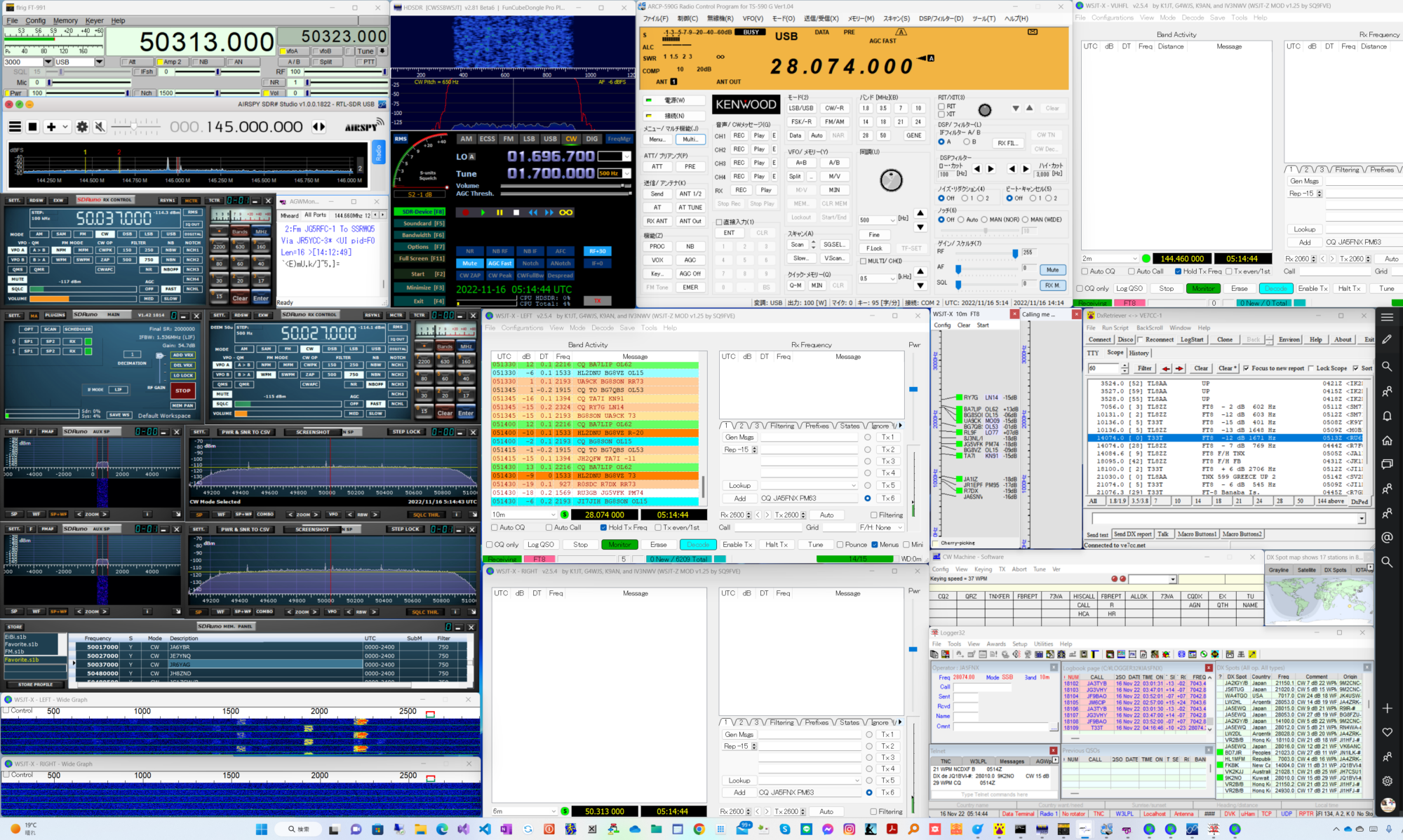Plans for WSJT-X Version 2.0
—————————-
This white paper describes a number of important enhancements planned
for WSJT-X Version 2.0. Most of them involve the FT8 and MSK144
protocols, which will be upgraded to use use 77-bit information
payloads rather than the present 72 or 75 bits. This modest increase
in information content will make possible new message types that
support the following special types of QSOs and exchanged information:
1. NA VHF Contest operation with full and transparent support of grid
locators and “/R” (Rover) callsigns
2. EU VHF Contest operation with the exchange of 6-digit locators, QSO
serial numbers, and “/P” (portable) callsigns
3. ARRL Field Day operation with standard Field Day exchanges
4. ARRL RTTY Roundup operation with standard contest exchanges
5. Better and more user-friendly support for compound and nonstandard
callsigns
6. A special “telemetry” message format for exchange of arbitrary
information (up to 71 bits)
Decoding sensitivity for the new messages will be essentially the same
as for the FT8 and MSK144 modes presently in WSJT-X v1.9.1. The
existing FT8 DXpedition mode will still be supported, and a more
powerful DXpedition mode may be offered as well.
In this document we’ll call the new FT8 protocol “FT8+”. It will be a
superset of the FT8 implemented in v1.9.1, providing at least
temporary compatibility and inter-operability with older program
versions. We may decide to remove support for old-style 72- and
75-bit messages after a specified switchover interval.
In contrast, the new MSK144 protocol will replace the old one without
backward compatibility. We believe the smaller and more specialized
group of MSK144 users will upgrade quickly and not find this
restriction to be a problem.
Here are some examples of message formats that will be supported by
FT8+ and MSK144 in WSJT-X v2.0. The list is not exhaustive.
Parameters i3 and n3 (shown in column 1) are used in the software to
define major and minor 77-bit message types.
———————————————————————————-
i3.n3 Example Messages Comments
———————————————————————————-
0.0 TNX BOB 73 GL Free text
0.1 K1ABC RR73; W9XYZ -08 DXpedition Mode (sent only by Fox)
0.2 G4ABC/P R 570007 JO22DB EU VHF Contest
0.2 PA9XYZ 590003 IO91NP EU VHF Contest
0.3 K1ABC W9XYZ 6A WI ARRL Field Day
0.3 W9XYZ K1ABC R 2B EMA ARRL Field Day
0.5 123456789ABCD Telemetry (18 hex digits)
1. W9XYZ Compound call
1. W9XYZ 73
1. CQ FD K1ABC FN42
1. CQ K1ABC FN42
1. CQ TEST K1ABC FN42 NA VHF Contest (“TEST” is optional)
1. CQ TEST K1ABC/R FN42
1. K1ABC W9XYZ EN37
1. K1ABC W9XYZ -09
1. K1ABC W9XYZ R-17
1. K1ABC W9XYZ RRR
1. K1ABC W9XYZ 73
1. K1ABC W9XYZ RR73
1. K1ABC/R W9XYZ EN37
1. K1ABC W9XYZ/R RR73
1. W9XYZ -13 Nonstandard call
1. W9XYZ R+02
1. W9XYZ RRR
1. W9XYZ RR73
2. CQ G4ABC/P IO91
2. G4ABC/P PA9XYZ JO22
2. PA9XYZ G4ABC/P RR73
3. K1ABC KA0DEF 559 MO ARRL RTTY Roundup
3. K1ABC W9XYZ 579 WI ARRL RTTY Roundup
3. KA1ABC G3AAA 529 0013 ARRL RTTY Roundup
3. TU; G3AAA K1ABC R 559 MA ARRL RTTY Roundup
3. TU; KA0DEF K1ABC R 569 MA ARRL RTTY Roundup
3. W9XYZ K1ABC R 589 MA ARRL RTTY Roundup
4. CQ KH1/KH7Z Compound call
4. CQ YW18FIFA Nonstandard call
———————————————————————————-
Here are some examples of minimal QSO sequences that take advantage
(where necessary) of the new protocol capabilities. Model QSOs number
1 and 2 are supported already, with the present FT8 and MSK144
protocols, and number 3 with the existing FT8 DXpedition Mode. Model
QSOs 4-8 (and others not illustrated here) require the new protocols
with 77-bit messages.
———————————————————————————-
1. Standard QSO
———————————————————————————-
CQ K1ABC FN42
K1ABC W9XYZ EN37
W9XYZ K1ABC -11
K1ABC W9XYZ R-09
W9XYZ K1ABC RRR
K1ABC W9XYZ 73
———————————————————————————-
2. Short-cycle QSO
———————————————————————————-
CQ K1ABC FN42
K1ABC W9XYZ -09
W9XYZ K1ABC R-11
K1ABC W9XYZ RR73
W9XYZ K1ABC 73
———————————————————————————-
3. FT8 DXpedition Mode
———————————————————————————-
CQ KH1/KH7Z
KH7Z K1ABC FN42
K1ABC KH7Z -12
KH7Z K1ABC R-14
KH7Z W9XYZ EN37
… possibly other callers …
K1ABC RR73; W9XYZ -08
———————————————————————————-
4. ARRL Field Day
———————————————————————————-
CQ FD K1ABC FN42
K1ABC W9XYZ 6A WI
W9XYZ K1ABC R 2B EMA
K1ABC W9XYZ RR73
———————————————————————————-
5. ARRL VHF Contests
———————————————————————————-
CQ TEST K1ABC/R FN42
K1ABC/R W9XYZ EN37
W9XYZ K1ABC/R R FN42
K1ABC/R W9XYZ RR73
———————————————————————————-
6. ARRL RTTY Contest
———————————————————————————-
CQ TEST K1ABC FN42
K1ABC W9XYZ 579 WI
W9XYZ K1ABC R 589 MA
K1ABC W9XYZ RR73
———————————————————————————-
7. EU VHF Contest
———————————————————————————-
CQ TEST G4ABC/P IO91
G4ABC/P PA9XYZ JO22
PA9XYZ 590003 IO91NP
G4ABC/P R 570007 JO22DB
PA9XYZ G4ABC/P RR73
———————————————————————————-
8. Compound call
———————————————————————————-
CQ PJ4/K1ABC
W9XYZ
W9XYZ K1ABC -11
K1ABC W9XYZ R-09
W9XYZ RRR
W9XYZ 73
———————————————————————————-
To minimize confusion that’s likely to arise during a switchover from
v1.9.1 to v2.0, we propose to follow a well advertised schedule:
“RC1 Date” — perhaps as early as September 15, 2018?
——————————————————-
This will be the first chance for beta testers to try WSJT-X using the
77-bit messages. We may restrict this opportunity to specific
volunteer testers, and we’ll probably include an “upgrade by
xxxx_date” message to remind people that they are using a release
intended only for testing.
FT8+ will support the old (v1.9.1) protocol as well as the new message
types outlined above. To avoid QRMing legacy FT8 users with messages
they can’t decode, we’ll recommend testing FT8+ on frequencies
formerly used for JT9.
MSK144 will be fully functional between any two stations using the RC1
software, but it will not be backward compatible with earlier program
versions.
“RC2, RC3,… Date” — perhaps in October?
——————————————–
As needed, depending on results of testing.
GA Release Date — perhaps in November?
———————————————
Official General Availability release of WSJT-X v2.0.0. The original
MSK144 protocol will be declared obsolete.
For reference: Dates of relevant upcoming ARRL contests
——————————————————-
VHF QSO Party: September 8-10, 2018
RTTY Roundup: January 5-6, 2019
VHF SS: January 19-21, 2019
Our proposed schedule should make WSJT-X Version 2.0 usable for
relevant ARRL operating events in 2019.
